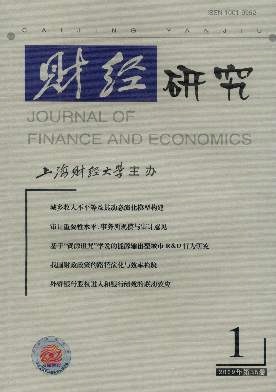基于“资源诅咒”学说的能源输出型城市R&D行为研究——理论解释及其实证检验
财经研究 2009 年 第 35 卷第 01 期, 页码:62 - 74
摘要
参考文献
摘要
文章在Romer的R&D增长模型基础上,将一个纯资本密集型的能源开发部门引入其中,并在最终产品生产函数中加入了能源生产要素,建立了能源输出型城市的四部门内生增长模型,对能源开发与R&D行为之间的关系进行了市场竞争动态均衡分析及平衡增长路径的比较静态分析,为我国能源输出型城市遭受的"资源诅咒"现象提出了一种理论解释,即能源开发对R&D行为的挤出效应。文章还利用36座中国典型的能源输出型城市的面板数据样本对上述理论推断进行了有效验证。最后给出了我国能源输出型城市经济发展的政策建议。
[1]胡援成,肖德勇.经济发展门槛与自然资源诅咒——基于我国省际层面的面板数据实证研究[J].管理世界,2007,(4):15-23.
[2]盛科荣,孙威.中国矿业城市经济增长的因素分析[J].矿业研究与开发,2004,24(3):5-8.
[3]邵帅,齐中英.西部地区的能源开发与经济增长——基于“资源诅咒”假说的实证分析[J].经济研究,2008,(4):147-159.
[4]徐康宁,王剑.自然资源丰裕程度与经济发展水平关系的研究[J].经济研究,2006,(1):78-89.
[5]Gylfason T,Zoega G.Natural resources and economic growth:The role of invest ment[J].The World Economy,2006,29(8):1091-1115.
[6]Gylfason T.Natural resources,education,and economic development[J].European E-conomic Review,2001,(45):847-859.
[7]Matsen E,Torvik R.Opti mal Dutch disease[J].Journal of Development Economics,2005,(78):494-515.
[8]Papyrakis E,Gerlagh R.The resource curse hypothesis and its transmission channels[J].Journal of Comparative Economics,2004,(32):181-193.
[9]Papyrakis E,Gerlagh R.Natural resources,innovation,and growth[R].Working Pa-per No.129.04,http://www.if w-kiel.de/VRCent/DEGIT/paper/degit_10/C010_054.pdf,2004.
[10]Papyrakis E,Gerlagh R.Resource abundance and economic growth in the United States[J].European Economic Review,2006,(4):253-282.
[11]Papyrakis E,Gerlagh R.Resource windfalls,invest ment,andlong-termincome[J].Resources Policy,2006,(31):117-128.
[12]Romer P M.Endogenous technological change[J].Journal of Political Economy,1990,98(5):71-102.
[13]Sachs J D,Warner A M.The big push,natural resource booms and growth[J].Jour-nal of Development Economics,1999,(59):43-76.
[14]Sachs J D,Warner A M.Natural resources and economic development:The curse of natural resources[J].European Economic Review,2001,(45):827-838.
[2]盛科荣,孙威.中国矿业城市经济增长的因素分析[J].矿业研究与开发,2004,24(3):5-8.
[3]邵帅,齐中英.西部地区的能源开发与经济增长——基于“资源诅咒”假说的实证分析[J].经济研究,2008,(4):147-159.
[4]徐康宁,王剑.自然资源丰裕程度与经济发展水平关系的研究[J].经济研究,2006,(1):78-89.
[5]Gylfason T,Zoega G.Natural resources and economic growth:The role of invest ment[J].The World Economy,2006,29(8):1091-1115.
[6]Gylfason T.Natural resources,education,and economic development[J].European E-conomic Review,2001,(45):847-859.
[7]Matsen E,Torvik R.Opti mal Dutch disease[J].Journal of Development Economics,2005,(78):494-515.
[8]Papyrakis E,Gerlagh R.The resource curse hypothesis and its transmission channels[J].Journal of Comparative Economics,2004,(32):181-193.
[9]Papyrakis E,Gerlagh R.Natural resources,innovation,and growth[R].Working Pa-per No.129.04,http://www.if w-kiel.de/VRCent/DEGIT/paper/degit_10/C010_054.pdf,2004.
[10]Papyrakis E,Gerlagh R.Resource abundance and economic growth in the United States[J].European Economic Review,2006,(4):253-282.
[11]Papyrakis E,Gerlagh R.Resource windfalls,invest ment,andlong-termincome[J].Resources Policy,2006,(31):117-128.
[12]Romer P M.Endogenous technological change[J].Journal of Political Economy,1990,98(5):71-102.
[13]Sachs J D,Warner A M.The big push,natural resource booms and growth[J].Jour-nal of Development Economics,1999,(59):43-76.
[14]Sachs J D,Warner A M.Natural resources and economic development:The curse of natural resources[J].European Economic Review,2001,(45):827-838.
引用本文
邵帅, 齐中英. 基于“资源诅咒”学说的能源输出型城市R&D行为研究——理论解释及其实证检验[J]. 财经研究, 2009, 35(1): 62–74.
导出参考文献,格式为:





 6921
6921  4478
4478

